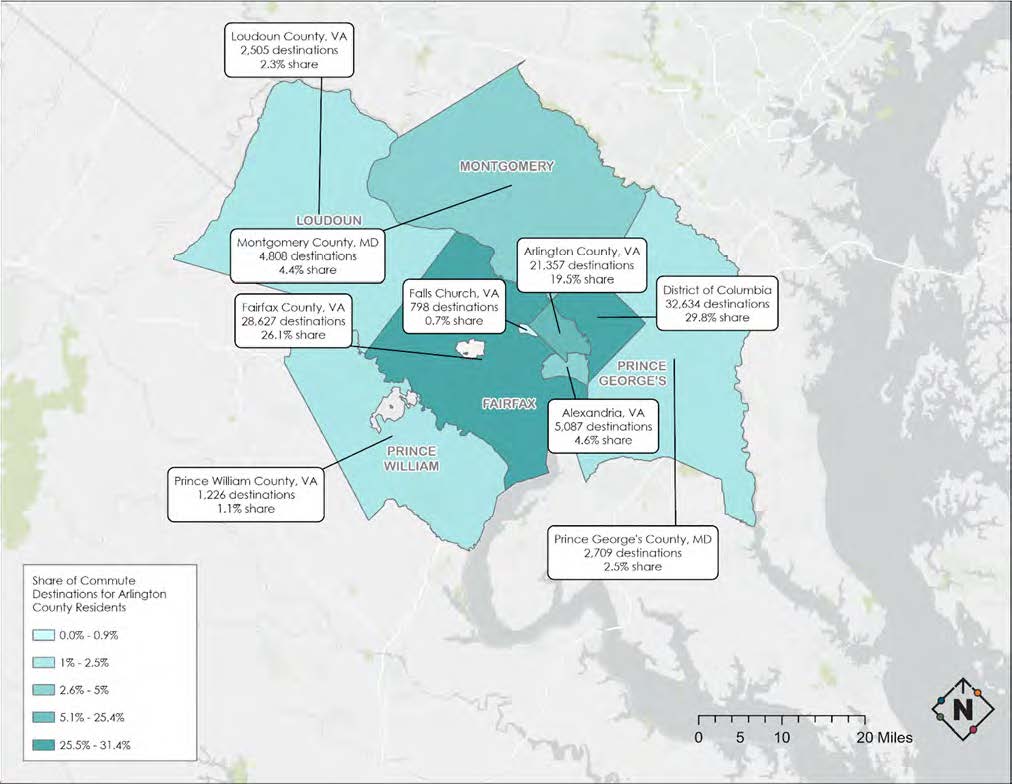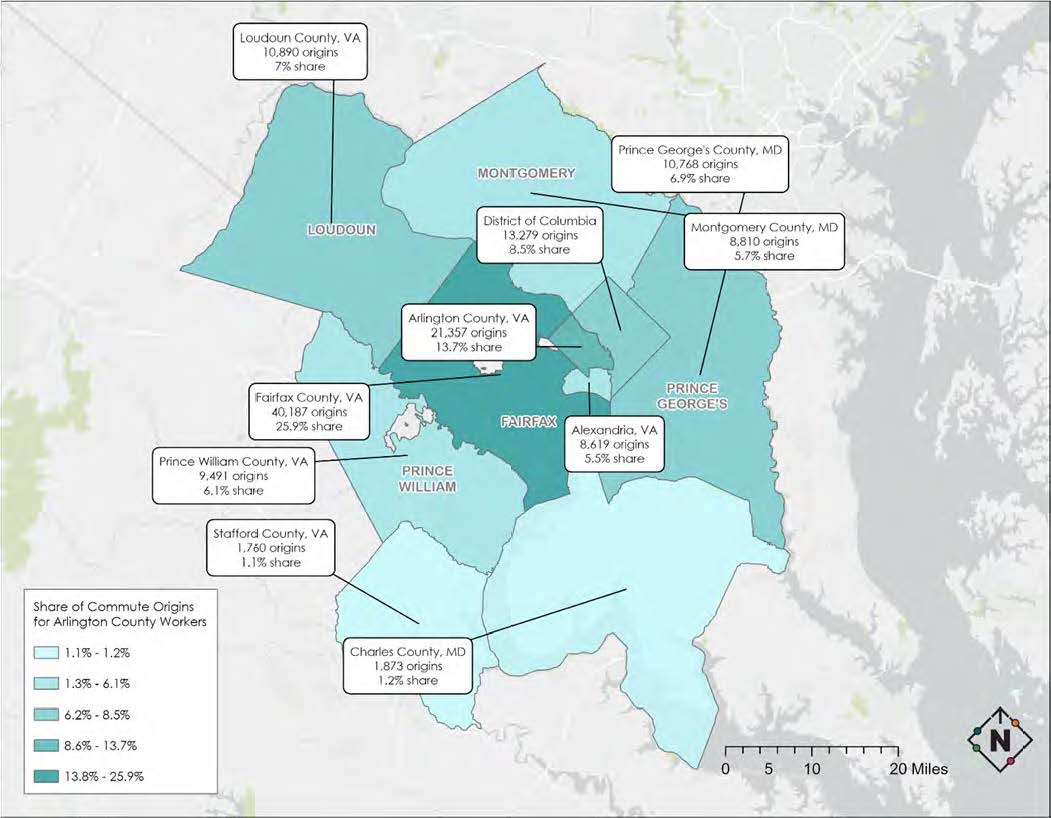Chapter 2, Part 2, ACCS Strategic Plan
This text-only version is offered as a more accessible alternative to this PDF document: Arlington County Commuter Services Transportation Demand Management Plan (PDF, 3.85 MB).
EMPLOYERS
There are 9,648 employers in Arlington County. The 10 largest employers in the County and their industries are shown in Table 8. Four of the top 10 employers are in the public sector and include the US Department of Homeland Security, Arlington County Public Schools, and the County government. Private sector employers range from professional services to airlines and hospitals.13
Table 8: Arlington County Largest Employers
|
Rank |
Employer | Sector | Industry |
|---|---|---|---|
|
1 |
US Department of Defense |
Public |
Federal Government |
|
2 |
Arlington County School Board |
Public |
Educational Services |
|
3 |
Accenture National Securities |
Private |
Professional, Scientific, and Technical Services |
|
4 |
United Airlines Inc |
Private |
Transportation and Warehousing |
|
5 |
County of Arlington |
Public |
Local Government |
|
6 |
Deloitte Consulting LLP |
Private |
Professional, Scientific, and Technical Services |
|
7 |
Fannie Mae |
Private |
Finance and Insurance |
|
8 |
US Department of Homeland Security |
Public |
Federal Government |
|
9 |
Virginia Hospital Center |
Not-for-Profit |
Health Care and Social Assistance |
|
10 |
American Airlines Inc |
Private |
Transportation and Warehousing |
Employer Size
Figure 7 shows the share of Arlington County employers by their number of employees. Most of the employers are small—78 percent of Arlington's employers have fewer than 10 employees and 95 percent have fewer than 50 employees. Of the larger employers, 556 employers have more than 50 employees (five percent) and only 17 of those have more than 1,000 employees.14
The nearly 560 employers with more than 50 employees and the additional 750 employers with more than 20 may be the best candidates for participation in traditional TDM programs, since these employers can reach larger numbers of people and have the administrative capacity to manage such programs, thereby leveraging limited county resources. However, TDM services are currently offered and will continue to be offered to smaller companies in a way that meets their unique needs.
Figure 7: Number of Arlington County Employers by Size

Employer Industries
Neither employers nor employees in Arlington County are highly concentrated by sector (Table 9). 15 However, in some sectors, a small number of employers account for a larger number of employees—for example, government sector employers make up two percent of all employers but employ 22 percent of all workers in Arlington County.16 Considering employment by sector provides insight into how many of the region's employees might be able to reduce their amount of commuting or shift their commute to non-SOV modes, acknowledging that company and agency policy also has a large impact on how often employees commute to their work location. For example, companies in the professional services and finance sectors might be good targets for telework outreach, while the education, health services and leisure/hospitality sectors might be better targets for other types of TDM programming such as promotion of sustainable commute modes.
15 Source: US Bureau of Labor Statistics, Quarterly Census of Employment and Wages (QCEW), 1st Quarter (January, February, March) 2023, County High-Level Summary File. https://www.bls.gov/cew/downloadable-data-files.htm. Note that the time period covered by this source is different from the period covered by the source for Table 7.
16 Note that LED data cited in Table 7 shows a public sector employment of 7 percent as compared to 22 percent in the QCEW data; each source uses a different definition of public and private industry.
Table 9: Employers and Employees by Sector
|
Sector |
Employers |
Employees |
||
|---|---|---|---|---|
|
Number |
% of Total |
Number |
% of Total |
|
|
Professional and business services |
3,546 |
32% |
58,343 |
34% |
|
Government |
190 |
2% |
38,297 |
22% |
|
Trade, transportation, and utilities |
842 |
8% |
20,525 |
12% |
|
Leisure and hospitality |
806 |
7% |
15,986 |
9% |
|
Education and health services |
1,052 |
10% |
13,473 |
8% |
|
Other services |
2,644 |
24% |
10,778 |
6% |
|
Financial activities |
895 |
8% |
6,484 |
4% |
|
Information |
350 |
3% |
5,725 |
3% |
|
Construction |
254 |
2% |
2,202 |
1% |
|
Manufacturing |
120 |
1% |
770 |
0% |
|
Unclassified |
345 |
3% |
526 |
0% |
|
Natural resources and mining |
7 |
0% |
33 |
0% |
|
Total |
11,051 |
100% |
173,142 |
100% |
WORKFORCE TRAVEL PATTERNS
Commute Breakdown
Figure 8 visualizes the breakdown in commute trips between people who live and work in the County (resident workers), people who live in the County but work outside it (out-commuters), and people who work in the County but live outside it (in-commuters). Roughly 247,000 commuters fall within ACCS's purview, comprised of approximately 23,000 resident workers, 89,000 out-commuters, and 135,000 in-commuters. About 224,000 workers commute into or out of Arlington County, compared to 23,000 who both live and work in the County.17
Note that Figure 8 represents administrative data reported by the Census' LEHD Origin- Destination Employment Statistics program as of 2021. Thus, the total worker counts differ from Table 7, which shows US Census Bureau Local Employment Dynamics (LED) Program, 2nd Quarter (April, May, June) 2022 data.
Figure 9 and Figure 10 show the most common commute destinations for Arlington County residents and commute origins for Arlington County workers, respectively. The District of Columbia was the most common commute destination for Arlington County residents, while Fairfax County was the most common commute origin for Arlington County workers.18
17 Source: US Census Bureau, LEHD Origin-Destination Employment Statistics (2021). Accessed at https://onthemap.ces.census.gov
18 Source: US Census Bureau, LEHD Origin-Destination Employment Statistics (2021). Accessed at https://onthemap.ces.census.gov
Figure 8: Service Area Commute Flows

Figure 9: Share of Commute Destinations for Arlington County Residents

Figure 10: Share of Commute Origins for Arlington County Workers

Mode Share
Arlington County residents, workers, and visitors travel to work and other destinations by a variety of modes, based on commute and non-commute mode share data from various sources—namely a 2021 resident survey, the American Community Survey (ACS), and location-based data. These sources indicate that driving alone is the most common mode for both commute and non-commute trips. Though telework has substantially reduced the number of commute trips taken, driving alone remains the most common commute mode.
However, Arlington residents and commuters to Arlington have very large non-drive-alone commute mode share compared to the rest of the region and Virginia.19 Survey and ACS data indicate between 15 and 35 percent and Replica indicates upwards of 50 percent of commute trips are taken by transit, active modes, and carpool/vanpool. These data sources also indicate that while drive-alone rates for commute and non-commute trips are similar, when it comes to alternative modes, transit accounts for a greater share of commute trips, and biking and walking account for a greater share of non-commute trips.
The following sections provide a detailed review of each data source.
Arlington Resident Travel Survey
Table 10 includes commute mode share data from the 2021 Arlington Resident Travel Survey. Weekly commute trips were approximately 20 percent driving alone/taxi/ride-hail, 15 percent transit or active transportation modes, and 65 percent telework countywide. This survey was conducted when telework was still very high due to the COVID-19 pandemic.
Figure 11 breaks these countywide survey results down into six home areas.20 Of these, the Route 1 and Rosslyn-Ballston corridors had the lowest drive-alone rates, and the Columbia Pike and Other South Arlington areas had the highest drive-alone rates.
Figure 12 compares the aforementioned 2021 commute mode share data from the Arlington Resident Travel Survey to the 2015 results. Overall travel decreased substantially due to increased teleworking due to the pandemic. Of the trips taken in 2021, driving alone and biking accounted for a higher share as compared to 2015, while transit, walking, and carpooling accounted for a lower share as compared to 2015. In 2021, driving alone and transit were the most popular modes for commute trips actually taken (i.e., all non-telework modes), as they were 2015.
In addition to commute more share data, Table 10 includes non-commute mode share data. This data is expressed by the percentage of respondents who used each mode for a non-work trip during the most recent weekday or weekend. Seventy-four percent of respondents drove alone for a non-work trip, 48 percent walked, 27 percent used carpooling/vanpooling, and 20 percent took a train (because multiple responses were permitted, responses do not total 100 percent). As noted above, mode choice might have been impacted by health concerns still at play due to the pandemic.
19 According to American Community Survey (ACS) Five-Year Estimates (2021), Table B08006, Arlington County's non-drive alone commute share is 56 percent, compared to 39 percent for the Washington- Arlington-Alexandria, DC-VA-MD-WV Metro Area, and 27 percent for Virginia as a whole.
20 The survey defined the Columbia Pike area as zip codes that extended approximately one-half mile corridor around the Columbia Pike roadway; the Rosslyn-Ballston and Route 1 areas as approximately one-quarter mile corridors around the Metrorail Orange and Metrorail Blue lines, respectively; Shirlington as the zip code that included Shirlington Village Center; and “Other” North and South Arlington as all other areas of the county north and south of Route 50, respectively.
This text-only version is offered as a more accessible alternative to this PDF document: Arlington County Commuter Services Transportation Demand Management Plan (PDF, 3.85 MB).